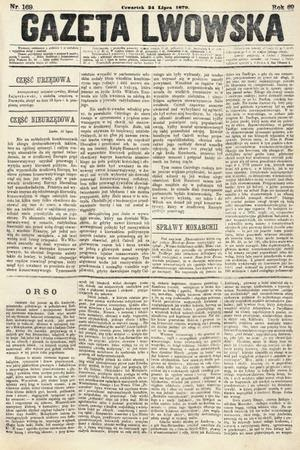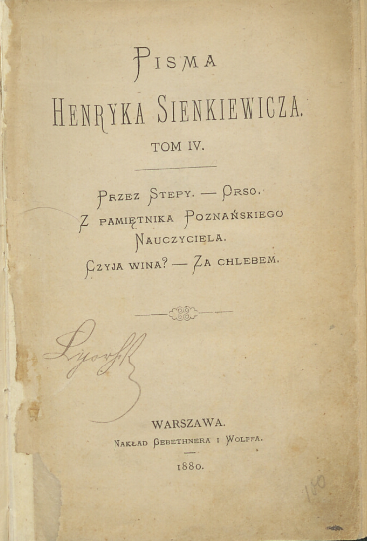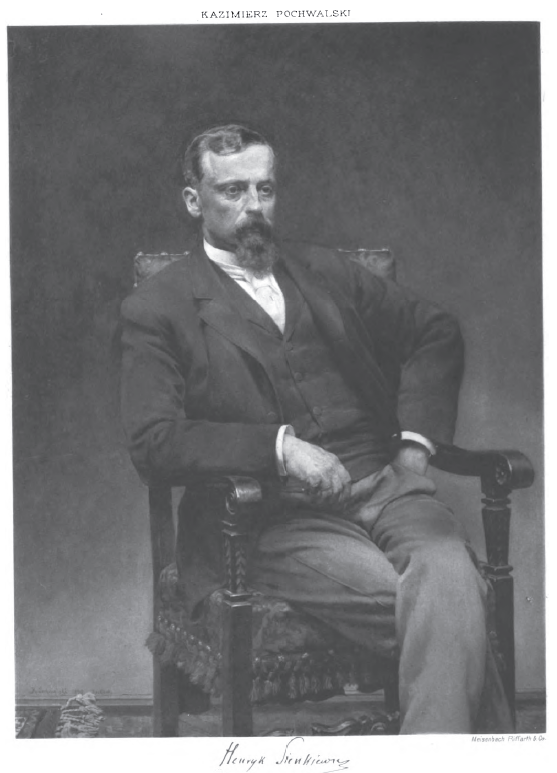Title of the work
Country of the First Edition
Country/countries of popularity
Original Language
First Edition Date
First Edition Details
Henryk Sienkiewicz, “Orso”, Gazeta Lwowska 169–172 (1879): 1.
Full text: Pisma Henryka Sienkiewicza. Tom IV. Przez stepy; Orso; Z pamiętnika poznańskiego nauczyciela; Czyja wina?; Za chlebem. Warszawa: Gebethner i Wolff, 1880, 107–141.
Available Onllne
Gazeta Lwowska 169 (1879), jbc.bj.uj.edu.pl (accessed: September 24, 2020).
Gazeta Lwowska 170 (1879), jbc.bj.uj.edu.pl (accessed: September 24, 2020).
Gazeta Lwowska 171 (1879), jbc.bj.uj.edu.pl (accessed: September 24, 2020).
Gazeta Lwowska 172 (1879), jbc.bj.uj.edu.pl (accessed: September 24, 2020).
Full text: Pisma Henryka Sienkiewicza. Tom IV. Przez stepy; Orso; Z pamiętnika poznańskiego nauczyciela; Czyja wina?; Za chlebem, Warsaw: Gebethner i Wolff, 1880, 107–141 (accessed: September 24, 2020).
Genre
Short stories
Target Audience
Crossover (Teenagers)
Cover

Gazeta Lwowska, Jagiellońska Biblioteka Cyfrowa, public domain.

Pisma Henryka Sienkiewicza. Tom IV, Biblioteka Narodowa, public domain.
Author of the Entry:
Summary: Agata Więcławska, University of Warsaw, a.wieclawska@student.uw.edu.pl
Analysis: Marta Pszczolińska, University of Warsaw, m.pszczolinska@al.uw.edu.pl
Peer-reviewer of the Entry:
Katarzyna Marciniak, University of Warsaw, kamar@al.uw.edu.pl
Elżbieta Olechowska, University of Warsaw, elzbieta.olechowska@gmail.com

Painting of Henryk Sienkiewicz by Kazimierz Pochwalski (1855–1940), retrieved from Wikimedia Commons.
Henryk Sienkiewicz
[Litwos] , 1846 - 1916
(Author)
An eminent writer, journalist, social activist, one of the most popular Polish authors of the turn of the 19th and 20th centuries, pen-name Litwos. Dedicated and experienced traveller, he was knowledgeable about Antiquity. In 1876–1878, he was a correspondent for “Gazeta Polska” in North America, mainly in California. In 1874–1878, he was a co-owner of the scientific-literary magazine “Niwa,” in 1882–1887 he worked as editor of the conservative journal “Słowo.” He became famous as novelist focusing on the history of 17th-century Poland. His best known historical novels are Trylogia [The Trylogy]: Ogniem i mieczem [With Fire and Sword], 1884, Potop [The Deluge], 1886, and Pan Wołodyjowski [Sir Michael], 1888; other famous novels include a narrative of the time of Nero, Quo vadis?, 1896; a book on the war between Jagiellonian Poland and the Teutonic Knights Krzyżacy [The Knights of the Cross], 1900; a popular adventure story for young people W pustyni i w puszczy [In Desert and Wilderness], 1912. He wrote also short stories, e.g. Szkice wę̨glem [Sketches in Charcoal], 1877, Janko Muzykant [Janko the Musician], 1878, Latarnik [Lighthouse Keeper], 1881, and many others. For years many of his books have been compulsory and suggested readings at school. In 1905, he received the Nobel Prize in Literature for lifetime achievement as an epic writer. Many of Sienkiewicz books were made into films.
Sources:
"Sienkiewicz Henryk", in Nowa Encyklopedia Powszechna A–Z, Kraków: Krakowskie Wydawnictwo Naukowe, 2010, 877.
"Sienkiewicz Henryk", in Encyklopedia Popularna PWN, Warszawa: Państwowe Wydawnictwo Naukowe, 1982, 706.
Julian Krzyż̇anowski, Twórczość Henryka Sienkiewicza, Warszawa: Państwowy Instytut Wydawniczy, 1970.
Radosław Najdyhor, Henryk Sienkiewicz – życie i twórczość, sienkiewicz.ovh.org (accessed: Septemper 30, 2020).
Bio prepared by Agata Więcławska, University of Warsaw, a.wieclawska@student.uw.edu.pl
Translation
Bulgarian: Orso, trans. Vasil Arnaudov, Sofia: Hemus, cenz., 1927.
English: Orso, trans. Marion Moore Coleman, Chesire, Conn.: Cherry Hill Books, 1973.
French: Pages d'Amérique; Pour le pain; A travers les Savanes; Orso, trans. B. Jardetski, Paris: Liberaire Nilsson, 1934.
Hungarian: A Római patrícius, Budapest: Fátum-Ars, 1994.
Latvian: Zirkus behrni = (Orso), trans. Jānis Alfreds Kukurs, Riga: I. A. Kukura apgahdeenâ, 1899.
Macedonian: Orso, trans. K. K'amilov, Skopje: Detska Radost, 1951 or 1952.
Romanian: Orso, trans. A. Rumu, Kišinèu: Kartâ Moldovenâskè, 1960.
Russian: Orso, trans. Âkov Osipovič Nemčinskij , Moskva, Leningrad: Gosud. Izd-vo Detskoj Literatury Min. Prosveščenija RSFSR, 1953.
Orso, trans. Âkov Osipovič Nemčinskij, Moskva: Gosud. Izd-vo Detskoj Literatury Min. Prosveščenija RSFSR, 1954.
Orso, trans. Âkov Osipovič Nemčinskij, Moskva: Detgiz, 1956.
Spanish: Orso; En rano, trans. Juan García Rodríguez, Madrid: La Espạna Moderna, 1904.
Spanish: Hania; Orso; El manantial, trans. A. Marcoff , Buenos Aires: Espasa-Calpe Argentina, 1948.
Summary
Based on: Katarzyna Marciniak, Elżbieta Olechowska, Joanna Kłos, Michał Kucharski (eds.), Polish Literature for Children & Young Adults Inspired by Classical Antiquity: A Catalogue, Faculty of “Artes Liberales”, Warsaw: University of Warsaw, 2013, 444 pp.
The action is set in a small town in Southern California, when after the time of grape harvest, begins a period of fun and celebrations. A travelling circus of Mr. Hirsch comes to town; performances by a couple of young artists, a 16-year-old strongman Orso and a beautiful athlete Jenny, are the circus’ main attraction. They spend a lot of time together, read the Bible and fall in love. They dream of sharing a house and starting a new family. Their increasingly closer relations begin to disturb the director of the circus. One day Mr. Hirsch decides to flog Jenny for a small offence. Then, for the first time, Orso opposes him. There is a fight. The young people run away from the circus. They find help in a friendly and hospitable farm. There, they are able to lead a quiet and happy life, free from fear and excessive hardships.
Analysis
Sienkiewicz’s short story takes place in an environment of Californian settlers contemporary to the author. The title character, Orso, arrives in Anaheim, where he is to perform as the main attraction of a travelling circus. He is a 16-year-old Métis whose mother is an American Indian. He is not too handsome, but quite muscular – with broad shoulders, a massive chest, sculpted abdominal muscles and relatively short legs; his stature recalls a bull or a bear. The boy is a taciturn introvert and appears dull. Disliked by the crew of the circus, he is a target of their scorn and teasing because of his ancestry. The circus director detests and fears him at the same time, tries to “raise him” through frequent thrashings and considers it a reward whenever he restrains from beating him. For publicity, but also out of recognition of his exceptional strength and skill, Orso is called “the American Hercules”. The circus programme states that, in accordance with this name, he is able to carry six men, three on each arm. In addition, the management offers a prize of $100 to anyone who can overcome the boy in a hand-to-hand fight. The young athlete, just like Hercules, has never been defeated, so a hunter called Grizzly-Killer prepares to fight him, which attracts the Californian public eager to see the fight and a Californian victorious, should the hunter prevail. In his next performance, Orso is to carry Jenny, a small, 13- year-old, beautiful girl, on a 30-foot mast.
Jenny is the only person who treats Orso well, which makes him care for her and become her friend in return. They share a dream of living in a real home together, a place different from the circus. When the sadistic director Hirsch wants to beat Jenny in his anger, Orso hears her screams and comes to her rescue like a real hero. Hirsch calls four of his men for help. In a vicious fight, the boy defeats all of them, takes the girl with him and together they leave the city going into wild, uninhabited country. Eventually, a lonely older man living in the wilderness gives them a helping hand and with his kindness, restores their faith in people/humanity.
The reference to the character of Hercules is not a coincidence. The most obvious similarity is his superstrength and athletic prowess, which is the reason for his nickname. Moreover, even though he is not shown as a positive or friendly person at first, Orso, like Hercules, chooses the just path of Arete/Virtue instead of the familiar, easy way which does not require him to change. In the moment of trial he stands up to brutality and violence and engages in combat with the director Hirsch who turns out to be a monster. The opponents whom Orso fought before were only a part of his circus duties, whilst the director embodies a real, evil beast, such as those fought by the mythical Hercules.
Sienkiewicz’s portrayal of the multiracial circus community was written almost a century and a half ago and corresponded to liberal views of the intellectual elite of that age. It centered on the behaviour of the community towards the two protagonists and the dehumanizing conditions of insecurity, oppression, and suffering created by the brutal director Hirsch and leading to mutual hatred and contempt.
Further Reading
"Sienkiewicz Henryk", in: Nowa Encyklopedia Powszechna A–Z, Kraków: Krakowskie Wydawnictwo Naukowe, 2010, 877.
"Sienkiewicz Henryk", in: Encyklopedia Popularna PWN, Warszawa: Państwowe Wydawnictwo Naukowe, 1982, 706.
Krzyżanowski, Julian, Twórczość Henryka Sienkiewicza, Warszawa: Państwowy Instytut Wydawniczy, 1970.
Najdyhor, Radosław, Henryk Sienkiewicz – życie i twórczość, sienkiewicz.ovh.org (accessed: Septemper 30, 2020).


